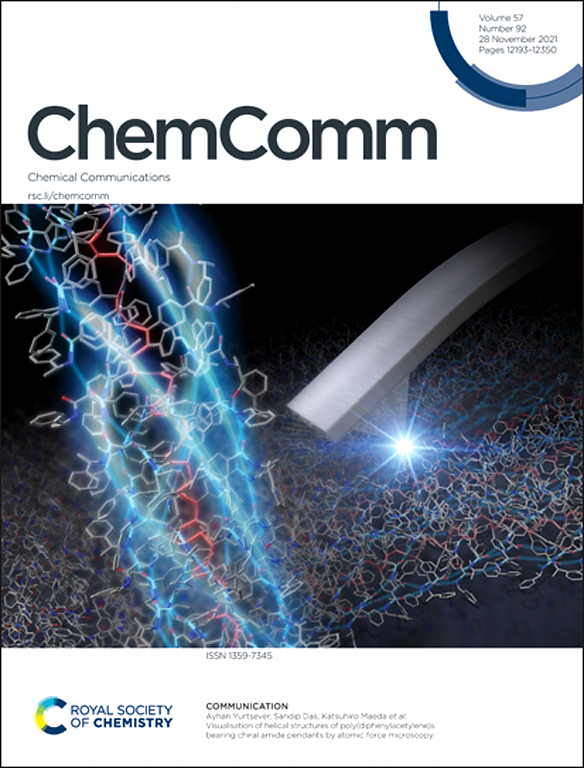Concurrent utilization of e- and h+ for water splitting to H2 and biomass component to value added products: Sustainable solar driven photocatalysis towards meeting SDG7, 12 and 13
IF 4.2
2区 化学
Q2 CHEMISTRY, MULTIDISCIPLINARY
引用次数: 0
Abstract
Photocatalytic water splitting is considered as one of the efficient methods for producing green hydrogen. However, the sluggish oxygen evolution reaction (OER) kinetics with four electrons limits the overall efficiency of water splitting. Biomass components/biomass derivatives are the renewable carbon feedstock and abundantly available in nature. It is prudent to make use of electrons and holes concurrently in photocatalysis for H2 production and oxidation of biomass components, respectively, due to latter’s occurrence at low potential (≤1 V) than OER (>1.23 V), to value-added products (VAPs); this approach makes the entire process to be energy-efficient and kinetically superior. This potential approach could effectively utilize the charge carriers as well as abundant renewable resources of water and biomass simultaneously, thus meeting the sustainability, energy conversion and economic goals together. Parallel utilization of the charge carriers for redox reactions also enhances the sustainability of the catalyst system employed. Interestingly, biomass component oxidation to VAPs occur in several steps, which not only enhances holes utilization, but also provides an opportunity to design better catalyst to enhance selectivity of the targeted product. Carrying out such reactions under aerobic or anaerobic conditions, and different pH conditions offer to fine tune the product selectivity. Current review provides a detailed overview of the recent developments in this emerging area with three different types of photocatalyst systems, such as oxide, chalcogenide, carbon-based materials. Among them, the oxide-based system demonstrated the higher activity with sustainability, maintaining performance over 300 h. While many of these systems exhibited high selectivity towards a single product, 100 % selectivity to lactic acid from glycerol was observed with BiVO4 integrated TiO2 catalyst. Finally, the challenges, opportunities and future perspectives in this thriving field is listed, and they underscore the role of carbon-neutral economy towards achieving a potentially sustainable future.同时利用e-和h+将水分解为H2,同时利用生物质成分生产附加值产品:可持续的太阳能驱动光催化,以满足SDG7、12和13
光催化水裂解被认为是生产绿色氢的有效方法之一。然而,缓慢的四电子析氧反应(OER)动力学限制了水分解的总体效率。生物质组分/生物质衍生物是可再生的碳原料,在自然界中储量丰富。在光催化生产H2和氧化生物质组分的过程中,应谨慎地同时利用电子和空穴,因为后者在低电位(≤1 V)下比OER (>1.23 V)更容易产生增值产品(VAPs);这种方法使整个过程节能和动力学优越。这种潜在的方法可以同时有效地利用电荷载体以及丰富的水和生物质可再生资源,从而同时满足可持续性、能量转换和经济目标。平行利用电荷载体进行氧化还原反应也提高了所采用的催化剂体系的可持续性。有趣的是,生物质组分氧化为VAPs发生在几个步骤中,这不仅提高了孔的利用率,而且为设计更好的催化剂以提高目标产物的选择性提供了机会。在好氧或厌氧条件下进行这种反应,以及不同的pH条件提供了微调产物选择性。本文以氧化物、硫族化合物、碳基材料等三种不同类型的光催化剂体系为例,详细介绍了这一新兴领域的最新进展。其中,基于氧化物的体系表现出更高的活性和可持续性,在300小时内保持性能。虽然许多这些体系对单一产物具有高选择性,但使用BiVO4集成的TiO2催化剂可以观察到对甘油中乳酸的100%选择性。最后,本文列出了这一蓬勃发展领域的挑战、机遇和未来前景,并强调了碳中和经济在实现潜在可持续未来方面的作用。
本文章由计算机程序翻译,如有差异,请以英文原文为准。
求助全文
约1分钟内获得全文
求助全文
来源期刊

Chemical Communications
化学-化学综合
CiteScore
8.60
自引率
4.10%
发文量
2705
审稿时长
1.4 months
期刊介绍:
ChemComm (Chemical Communications) is renowned as the fastest publisher of articles providing information on new avenues of research, drawn from all the world''s major areas of chemical research.
 求助内容:
求助内容: 应助结果提醒方式:
应助结果提醒方式:


